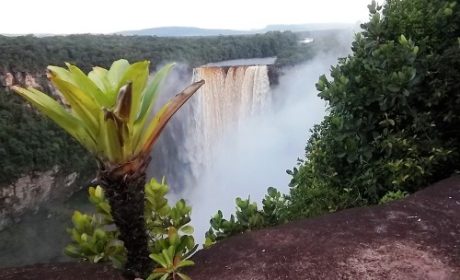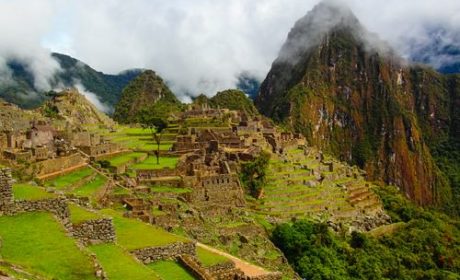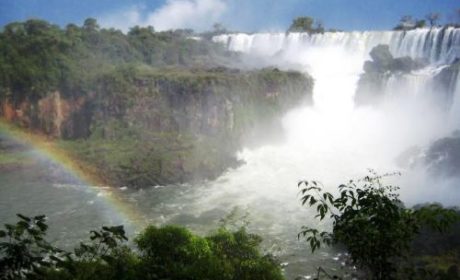Updated 09.25.2019: Peru is a favorite travel destination of many, most of whom visit to see iconic Machu Picchu. But, if you’re planning a trip to this amazing destination, why not take the time to see some of the lesser-known sites in the area?
Guest contributor Patti Morrow from Luggage and Lipstick is here to share her adventure hiking Chinchero, Peru—a.k.a. the birthplace of rainbows!
Where is Chinchero, Peru?
During a trip to Peru, Chinchero was the first Andean village on my schedule in the Sacred Valley, famous for its archaeologically important Inca sites and hiking routes. Eager to get to my “real” bucket list destination, Machu Picchu, I wasn’t expecting much.

After driving 19 miles from Cusco with AdventureSmith Explorations, I got out of our transport van and strolled over to the edge of a grassy knoll and looked down. Spread out beneath were rows-upon-rows of circular agricultural terraces moving down in steps. The fact that there were virtually no other tourists in sight only enhanced my first glimpse into the fascinating Inca culture.
According to local folklore, Chinchero is where the Incas claimed to be the birthplace of the rainbow. At an altitude of 12,500—even higher than Cusco—frequent rainbows appear in the sky, especially in rainy season.
Chinchero is known for its colonial buildings as well as its past as an important agricultural center during the reign of Inca Emperor Tahuantinsuyo.
What to see in Chinchero

Our group wandered through cobblestone streets of town to get to Chinchero’s main attraction—Inca ruins. At the archeological site, sweeping views of the snow-capped Chicón (18,140 ft ) as well as the Vilcabamba and Vilcanota mountain ranges dominate the landscape.
Stroll through the Old Town

Just outside of the ruins, on the central plaza, we immersed ourselves in an authentic indigenous market bursting with culture and color. It’s one of the most traditional markets in South America, complete with vendors wearing gorgeous traditional Peruvian apparel and hats, and women with long black braids running down their backs.
Myriad of handmade blankets, pachamama dolls, and other handicrafts were on offer spread out on canvases over a large grassy area. I was dazzled by such varied culture spread out before me—truly a feast for the eyes.

Visiting a Chinchero weaving co-op
Just outside of the archaeological area, we took a short drive to a traditional cooperative. Local women educate (and entertain!) visitors about centuries-old process of transforming and weaving alpaca wool into colorful textiles and soft sweaters so well-known of Peru’s Sacred Valley.
The process consists of washing raw wool in boiling water, letting it dry, and then spinning it onto a spool. We also saw a demonstration of natural dyes used to pigment the wool, and specific plants used to create different hues, such as cochineal beetles which turn into a deep red color.
Touring the Moray Inca Site

The stunning circular agricultural terraces at the ancient Inca site of Moray are one of the most incredible sights in Peru. Built into the hillside, my initial thought was that it resembled an amphitheater. But while no one knows for sure usage of the site, it is believed that the terraces were used for experimental agricultural purposes.
Each terrace is carved very naturally into the hillside, in conjunction with Inca respect for Pachamama, “Mother Earth.” Each platform represented a different micro-climate, so that Inca farmers could grow many different species of crops which would not ordinarily be found at that altitude.

There’s a path leading around Moray, allowing visitors to view all three terraces in about an hour, including walking down into rock formations at the base.
Hiking to the Maras Salt Mines

After a late lunch, we hiked from Chinchero center to the Maras Salt Mines. The journey to get to the salt pans was every bit as wonderful as the destination. It took about two hours on a winding downhill path which gave us an opportunity to thoroughly enjoy stunning views of the snow-capped Andes Mountain Range hugging the trail.

In continual use since Inca times, the mines are a series of large, rectangular pans forming terraces. Water from fresh mountain springs run into open-air pools where it is allowed to stagnate. Hot sun rays beating down on the pools, evaporate the water, and leaves behind natural salt still used by today’s Peruvians.
Did you know that we publish a weekly broadcast with the latest articles from My Itchy Travel Feet, timely trip inspiration and travel deals? Sign up by clicking here.
Disclosure:The author was honored to be the guest of Adventure Smith Explorations during her stay in Peru, but as always, the opinions, reviews and experiences are her own.



